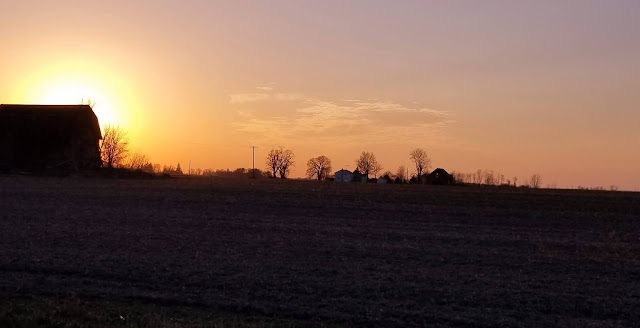>
 |
| Wheat Stubble in Winter Photo source: USDA NRCS, Public Domain |
It is the third week of January and there is a deep cover of snow on the ground. We haven't had much snowfall this winter and we need this blanket to protect the earth while it sleeps. Winter wheat, which was one of the crops grown on my family's cash crop farm, needs to be protected from icy winds and extremely cold temperatures. Planted in late summer, it starts to grow in the fall and by November, it looks like a field of green grass. In the spring, it begins to grow again and becomes a gorgeous field of gold that by summer takes my breath away. The depth of color and texture of a mature wheat field stops me in my tracks every time I see one and now, in the dead of winter with 20-degree days and windchills in the teens, by just thinking about it, I am transported to a place where gold surrounds me and the earthy smell of freshly harvested grain is in the air.
 |
| Golden rows of wheat straw create a patchwork image in a field that was once farmed by my family. |
When I close my eyes, I can envision the barn on our farm where the wheat was stored. Piled high after the harvest, the mountains of fresh little beads of wheat kernels were a great place for a farm kid to play, catch grasshoppers and chew on the delicate little wheatberries that were warmed by the sun just a few hours ago. The air in the barn was cool and in the late afternoon, the sun would cast shadows on the barn floor. Ribbons of ruby light would weave their way through the weathered boards to create a world suitable for the imagination of a little girl. The wheat crop not only gave us piles of wheat, tons of it if you read my father's diaries where he recorded every year's harvest; but also gave us glowing rows of golden straw as it was laid down from behind the John Deere combine in a pattern that has inspired many a patchwork quilt. As a child, fairy tales such as "Rumpelstiltskin" held my interest, although there was a rather sinister plot in that particular story. But, nevertheless, spinning straw into gold sounded quite wonderful to me. The wheat that found its way into my pockets and cuffs while climbing around in the barn, came spilling out onto my bedroom floor at night when I undressed. The sound was a sweet reminder of hours whiled away in the long afternoon of a summer day.
 |
| A view of one of the big barns on my family's farm with our 1860's Greek Revival house and horse barn in the distance. |
The wheat and straw that we harvested on our farm were grown as cash crops. The wheat was bagged and sold to growers as seed wheat and the straw was baled and stored in the mows in our barns. It was sold to buyers who sent huge flat bed trucks to our farm and was carried away 20 tons at a time. Some of it made its way to the racetracks where, I was told, the horses were very fussy and they liked our straw.
 |
| My dress form adorned with her glittery silver wreath. |
In January, it's nice to remember the sights, sounds, and smells of summer, but it is also important to me to give homage to the quiet slumber of the earth. In our home, I gravitate to colors that reflect the winter landscape in white and silver and for those infrequent days when we are relieved of our lake-effect cloud cover, I add some blue. It is like taking in a deep breath and slowly exhaling while it snows and we quietly wait for winter to wake from it's long sleep.
 |
| I made this wreath for our front porch last winter. Silver, white and blue is one of my a favorite color combinations for this time of year. |
Thank you for taking the time to read this post. I hope it may have evoked some memories for you. As always, your questions and comments are welcome. You can post them here on my blog or on Facebook. I will read each one and respond. It is my sincere wish that you and those you love are healthy, happy and safe. And, until we meet again, may the Lord hold you in the hollow of His hand.
Emmy
Go Bills! 🏈



